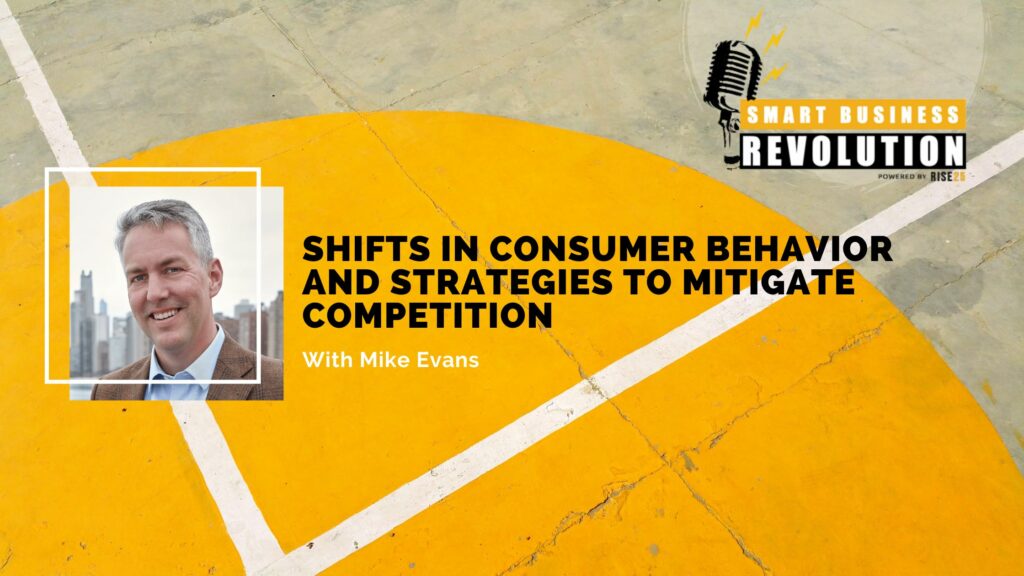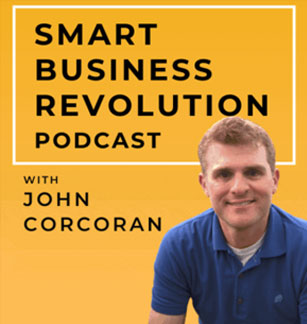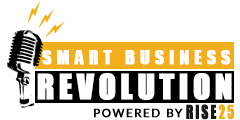

Mike Evans founded GrubHub in his spare bedroom and grew it into a multibillion-dollar online food delivery business. He led the company through five financing rounds, a couple of acquisitions, a merger, and ultimately, an IPO. Mike exited GrubHub after its IPO and founded Fixer, a Chicago-based on-demand handyman service. He is also the author of Hangry: A Startup Journey.
In this episode of the Smart Business Revolution Podcast, co-hosts John Corcoran and Roger Hurni interview Mike Evans, the Founder of Fixer and GrubHub, about how he started his companies. They also discuss shifts in consumer behavior, how to manage a company’s changing culture, and tips for handling competition.
Here’s a Glimpse of What You’ll Hear:
- What inspired Mike Evans to create GrubHub?
- How Mike sought content and restaurants for his website — and how his business model has evolved over the years
- How to manage a company’s changing culture
- The biggest technological challenges Mike faced building his business
- How to mitigate competition
- Why Mike decided to exit his company — and how he started Fixer
- Mike’s plans for Fixer and how he structured the company
- Mike talks about his book and the worst advice he has received
Resources Mentioned In This Episode
- Fixer
- GrubHub
- Mike Evans on LinkedIn
- Hangry: A Startup Journey by Mike Evans
- Roger Hurni on LinkedIn
- From Persona To Personal
- Off Madison Ave
- OpenTable
- “014: Glenn Allen of Open Table & Glyder | How OpenTable Pioneered Online Restaurant Reservations”
- Adam Zbar on LinkedIn
- Sunbasket
- Adventure Cycling Association
Sponsor: Rise25
At Rise25, we’re committed to helping you connect with your Dream 100 referral partners, clients, and strategic partners through our done-for-you podcast solution.
We’re a professional podcast production agency that makes creating a podcast effortless. Since 2009, our proven system has helped thousands of B2B businesses build strong relationships with referral partners, clients, and audiences without doing the hard work.
What do you need to start a podcast?
When you use our proven system, all you need is an idea and a voice. We handle the strategy, production, and distribution – you just need to show up and talk.
The Rise25 podcasting solution is designed to help you build a profitable podcast. This requires a specific strategy, and we’ve got that down pat. We focus on making sure you have a direct path to ROI, which is the most important component. Plus, our podcast production company takes any heavy lifting of production and distribution off your plate.
We make distribution easy
We’ll distribute each episode across more than 11 unique channels, including iTunes, Spotify, and Google Podcasts. We’ll also create copy for each episode and promote your show across social media.
Cofounders Dr. Jeremy Weisz and John Corcoran credit podcasting as being the best thing they have ever done for their businesses. Podcasting connected them with the founders/CEOs of P90x, Atari, Einstein Bagels, Mattel, Rx Bars, YPO, EO, Lending Tree, Freshdesk, and many more.
The relationships you form through podcasting run deep. Jeremy and John became business partners through podcasting. They have even gone on family vacations and attended weddings of guests who have been on the podcast.
Podcast production has a lot of moving parts and is a big commitment on our end; we only want to work with people who are committed to their business and to cultivating amazing relationships.
Are you considering launching a podcast to acquire partnerships, clients, and referrals? Would you like to work with a podcast agency that wants you to win?
Contact us now at [email protected] or book a call at rise25.com/bookcall.
Rise25 Cofounders, Dr. Jeremy Weisz and John Corcoran, have been podcasting and advising about podcasting since 2008.
Episode Transcript
Intro 0:14
Welcome to the revolution, the Smart Business Revolution Podcast where we ask today’s most successful entrepreneurs to share the tools and strategies they use to build relationships and connections to grow their revenue. Now, your host for the revolution, John Corcoran.
John Corcoran 0:40
All right, welcome, everyone. John Corcoran here. I’m the co-host of today’s episode, I will introduce our co-host in a second. This episode is actually gonna be pushed out across two different podcasts with a little different format here today. My podcast called Smart Business Revolution for the past 12 years has featured smart CEOs, founders, and entrepreneurs of companies and organizations ranging from Netflix to Kinkos’, Redfin, Quicken, YPO, EO, Activision Blizzard, and many more. And I also have with me, Roger Hurni. Roger, take it away.
Roger Hurni 1:06
Oh, thank you very much, John. I’m Roger Hurni. I host the show called From Persona To Personal, and the show focuses on leaders mostly in the food and beverage space, and it focuses on consumer behavior and how those shifts in behavior lead to different levels of personalization. I’ve had guests such as Kara Goldin founder Hint Water, and Eric Frederick, who’s the CEO of Pizzeria Uno.
John Corcoran 1:28
All right, let’s introduce today’s guest, we have Mike Evans. He founded GrubHub in his spare bedroom and grew it into a multibillion-dollar online food delivery Colossus, which is a household name today. He left GrubHub after the IPO, literally rode off into the sunset rode his bike all the way across the United States. And his book now is called Hangry: A Startup Journey. And more recently, he founded fixer.com, which is on demand handy person B Corp, that trains its employees from scratch. This episode, of course, brought to you by Rise25, where we help b2b businesses get clients referrals and strategic partnerships with done via podcast and content marketing. And you can learn more about us at Rise25.com. And also brought to you by Off Madison Ave. Roger’s company, which uses behavioral science to create meaningful moments of brand trust, which influences how people interact and engage with companies. And their behavioral approach taps into audience’s motivation and prompts them to shift behavior. Learn more at offmadisonave.com. All right, so Mike, off to you. I want to focus on the early days of GrubHub 2002, you started because yes, simple pain, you wanted order a pizza, and you weren’t able to, of course, this was a long, you know, in internet years, a lot of time ago. But take us back to that kind of lightning aha moment you were a programmer. So you knew how to develop this yourself. Tell us about what that original challenge was?
Mike Evans 2:53
Yeah. So like you said, back in 2002, I wanted a pizza and getting a pizza was hard. I live in a city that there’s tons of restaurants that deliver and I had, you know, maybe three or four menus in a little drawer that people had dropped off on my doorstep. And if you can imagine the time, it was really hard to find information for restaurants online, you could sort of find out which ones existed, but you couldn’t find which restaurants delivered to you. And so the very first idea was, I just wanted to find out which restaurants delivered to my address. And so I built a neighborhood guide on that. And then my business partner sold the first restaurant. And then shortly after that, I quit my job and and and started selling restaurants on this like delivery guide concept. It wasn’t even there was no online ordering. It was just an information website to start.
John Corcoran 3:40
Yeah, so and one of the interesting points that you did early on, because it was a marketplace, which is such a big challenge. You have to build the supply and the demand. And it’s kind of a unique challenge for a business that is a marketplace. You had to get all the content on there. You had to get the menus on there. We eventually had to get the restaurants to agree to go through your platform, but you had a little hack. You went through and you got you literally went out and got menus and put them onto the website.
Mike Evans 4:09
Yeah, like. So these kinds of businesses, they used to be called two sided network businesses. And more recently, they’ve been called marketplace businesses. The idea behind them is that you have a set of people on one side, in this case, restaurants, and the more of them you have, the more beneficial it is to diners. And the more diners you have, the more beneficial it is to restaurants and you need both for it to work and they suffer from this problem called the chicken and the egg problem. Do you get the diners versus the restaurants and whenever I talk to anybody who’s trying to do a marketplace, I always say you have to figure out a way to cheat one side of the marketplace you have to cheat you have to create value for one group before you create value for the other group. And so what what I did is I went and picked up all of the menus, the physical paper menus, scanned them and put them up on the website so that all of the menus for a restaurant you could find all the delivery menu restaurant delivery restaurant menus on the on the website was created value for the diners that were coming to the web It’s like before I had actually signed up anyone to do to do advertising on the website.
Roger Hurni 5:06
In consumer behavior, people don’t realize that consumer behavior is somewhat instinctive and they don’t know necessarily had the entire language. But what you did is a fundamental process in shifting consumer behavior. If you can make something easier, people will gravitate toward it. So you, you, you’ve solved that half that equation of making it easier to find what restaurants delivered to you. Here’s the menus from the actual restaurants. What shifted to the other side of the equation that you’re talking about? You solve that problem? And you got everything online? How do you solve for the the other audience and getting restaurants to really buy in from a delivery perspective?
Mike Evans 5:49
Yeah, so fast forward, like two years in the and I, it’s no longer just the delivery guide. It’s an online ordering platform. And like you said, on the consumer side, you know, I’ve had so many people say to me, well, what’s the big deal, you can just call on the phone, and it is a big deal, there’s a ton of friction and calling a restaurant on the phone, we want to use our phones or smartphones as remote controls for our lives. And so when we remove the friction from from having to call and be put on hold, and all that, it was 10 times better than than the previous experience, even though it doesn’t seem like it’s that hard to do a phone call. And so people went from bordering once a month, maybe maybe twice a month to twice a week. So we had a huge increase in in frequency, from people that started using a website. And that change in behavior, drove massive new customers with massive numbers of new customers to restaurants, and that was the sell to restaurants, we’d go to restaurants and we’d say, hey, we take on all the risk. We don’t make a dime unless you make $1. Sign up with us, and we’ll get you tons and tons of orders. And, you know, it works. So it still took convincing, it still took a sales team and conversations with lots of small business owners. But if you fast forward to like 2008, you know, during the house that 2007 2008 during the housing crisis, you know, we we had what we were calling at the time, the Great Recession, and lots of restaurants went out of business in a normal year. It’s like 30%. But this was like way north of that. And we were keeping our restaurants in business through a recession with our product. And so it worked. It worked for the restaurants, we drove tons of new business to them. This
Roger Hurni 7:21
saga Hydra was insane, because it definitely worked during that time period. And it seemed and I know you were you were probably out of it during the teens. I think you said 2011. I think you’ve been done.
Mike Evans 7:35
No, I was there at the IPO through the through through the IPO 14 Yeah. So
Roger Hurni 7:40
but the bit the pandemic became this other catalysts because I don’t think there’s anybody on the planet, particularly in the United States that has not least done some equivalent of a GrubHub order. Yeah, I
Mike Evans 7:53
mean, there was a few different moments along the course of running the business that were catalysts. You know, one was certainly certainly the, during the housing crisis, you know, one of the things one of the things that happens a lot of startups on a business and so we were able to spend on marketing very cheaply to get the name out about GrubHub. And we weren’t hurt ourselves by that particular moment. And then another one, which was just prior to that was, we had one of the first 100 iPhone apps in the App Store. And so you can imagine what an accelerant that was being really early on being in the app store. And there was a couple other apps that came around the same time, but they didn’t have 20,000 restaurants sign up like we had. And so there were a few accelerants along the way. And you know, it’s really hard to time those most of the time you just kind of have a tiger by the tail and you just hang on as as just try to like make sure to capture whatever that whatever that tailwind is, sometimes you do alright, sometimes you miss it.
John Corcoran 8:47
Did you have the business model figured out from the beginning? It must have evolved and changed over time. If in the early days, you didn’t even have the restaurant signed up? I don’t know, if you were like getting, you know, advertising revenue at that point. But did you have to kind of iterate and figure out what the business model would be as you went along? Or did you kind of have it clear in mind that the where the money was gonna come from,
Mike Evans 9:10
I had no idea what it was. I threw stuff on the wall and I saw it worked and I adapted and I changed and I and I made a lot of mistakes. I mean, i i That path from you know, one rest of the first restaurant to 70,000 restaurants was not like a clear, obvious straight line. It was like a drunken ramble. And and, you know, originally with the transition from the advertising platform where we were just you know, just doing exposure and just selling advertising packages to restaurants to online ordering. In the middle of that we I created a system to phone or to keep track phone orders so people would call the restaurant. Yeah, but it would go and actually go to a special number we had on the on the on the website and then now we get forwarded on to the restaurant. And the restaurants loved it at the time. Fast forward to to 10 to 15 years later, when people almost always exclusively use online ordering, restaurants hate that phone system. But so not only did it change over time, but some things that were valuable in the beginning became really, really a problem later on.
Roger Hurni 10:15
You know, Mike, I would, I would actually like to shift to go a little internal because that that kind of growth is is rare. I know, they talked about the whole unicorn thing. And I’ve been involved in a couple of like Doubletree hotels and Petsmart from its inception. The culture is really important. And you may not know what you’re doing, you’re figuring things out along the way. But there is a culture there. And as you grow, that culture shifts and changes. How did you how did you manage that? So that you could keep the energy that you had in the beginning? All the way through 70,000? Restaurants? Yeah,








